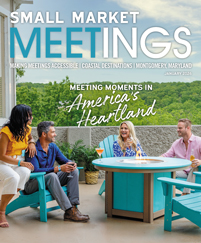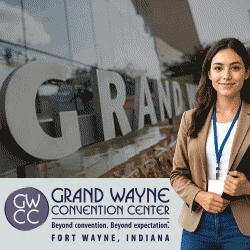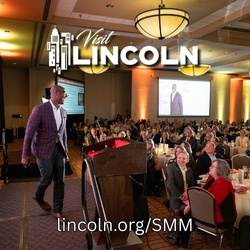About Andrea Cannistraci
Andrea Cannistraci is the president and founder of andgreat, a marketing, branding and events firm that helps businesses design and execute unique marketing programs. As a competitive bodybuilder, she integrates her love of fitness and wellness into her meeting planning.
Are your meetings helping people achieve their health and wellness goals — or, at the very least, not standing in the way of them?
Throughout society, there’s a growing interest in wellness. After the desperation and indulgence of the pandemic era, many people now are seeking healthier lifestyles. And while wellness priorities differ from one individual to the next, most share common themes, including mindfulness and intentional effort around eating, drinking and movement.
This pursuit of healthy living is impacting the meetings industry. Meeting attendees are increasingly looking for alternatives to typical event meal plans, and they’re eager for opportunities to move their bodies during conferences. Some wellness-focused events are even geared toward meeting planners.
While many planners may feel they are incorporating healthy choices and wellness activities into their events, in my view, many are falling short. If the point of a wellness-centric event is to help attendees stay energized, remain focused and motivated, and leave feeling inspired — and not completely depleted — meeting planners may need to reevaluate their strategy.
As a meeting professional and competitive bodybuilder, I have an admittedly distinctive view on health. And though bodybuilding isn’t for everyone, I have found that many of the principles I have learned from that lifestyle can easily be applied to meetings and events.
Here are some things to think about to ensure your next event offers a truly healthy and wellness-focused experience for your attendees.
1. Meals
For most people, a healthy lifestyle revolves around conscious food choices. And if you’re committed to providing healthy meals, you have probably started by working with the catering team to select lean proteins like fish and chicken, as well as farm-fresh veggies. That’s a great step, but you far from finished. Do you know how the chef will prepare those ingredients? If not, your good intentions may be undercut by longstanding culinary habits. Those lean proteins may be drowning in oils, accompanied by heavy carbs and slathered in sugary sauces. And there’s a good chance the veggies are swimming in butter and salt. So when you’re working with the catering team, ask not only what dishes they can provide but also how they will be prepared. Remember, what your attendees eat will affect their brains and their bodies.
2. Snacks
Everyone loves a good break during a long conference day — especially mid-afternoon, when attendees’ energy begins to flag. But not all breaks are created equal. If you’re in pursuit of healthy events, you need to ask yourself the honest question: Are you providing a snack break or a sugar break? I was recently at a conference for meeting planners where the snack break consisted of whole chocolate bars, including Twix, Hersheys, KitKat and Kind bars. (Yes, Kind bars are marketed as healthy food, but they are highly processed and contain many ingredients you may not be aware of.) You may be smart enough to steer clear of candy bars, but other snack pitfalls can be less obvious. Have you made the mistake of choosing “bran” muffins over regular muffins because they sounded healthier?
It’s important to know what is in the foods you are offering. One of the best ways to do that is to select fresh whole fruits for snack breaks — locally sourced, if possible. Fresh fruits have natural sugars and provide that sweetness your attendees are craving. Plus, they are easy on the budget — you only pay on consumption, so it’s cost effective. A trail mix with nuts and dried fruit (with no added sugar) is another healthy way to elevate your snacks.
3. Mocktails
Alcohol used to be de rigueur at many professional events. But with the sober-curious movement gaining steam, many meeting attendees today are choosing not to indulge in adult beverages. As a solution, many meeting venues and caterers offer mocktails — mixed drinks without the alcohol. And while this can be a great alternative for people who want to avoid alcohol’s intoxicating effects, it doesn’t solve the problem of its high sugar content. Most mocktails are made with sugar-added juices. So while offering mocktails might sound like a healthy choice, in reality you are simply swapping one sugar for another. That’s why it’s important to ask what is in the mocktails. Fresh-squeezed fruit juice mixed with seltzer water is a great, refreshing beverage choice with no added sugar.
4. Downtime
Wellness is about more than eating and drinking — it also requires exercise. But if your event agenda is jammed packed, with attendees forced indoors all day with no downtime, you may be making it difficult for them to work out. To solve this problem, consider starting a little later in the morning to allow attendees to hit the gym or go for a run outside. Better yet, offer a sponsored spin class or a yoga session — outdoors, if weather allows. And if your event format is flexible, consider offering seminars or workshop sessions outdoors on nice days. End your daytime agenda before 5 p.m., so attendees have time to answer emails or to call home to their families before evening events. A looser schedule will equate to a more relaxed attendee who is able to retain more of your content and is not drained by the end of the meeting.
5. Breaks
Nobody can do their best work without breaks throughout the day. To help attendees stay mentally sharp, incorporate a few 30-minute breaks during the day and make sure they include options for movement. That may be as simple as a walk around the venue, a short scavenger hunt or a standing-up networking session — anything to get your attendees out of their seats and increase their blood flow. Going outside for fresh air and natural light can also help reenergize attendees so they come back with a renewed focus.














